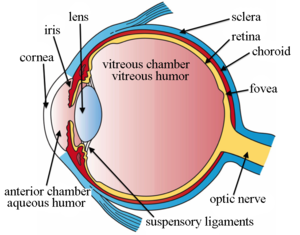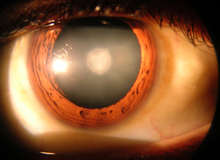Eyesight in the Elderly
Original Editor - Wendy Walker
Top Contributors - Wendy Walker, Lucinda hampton, Scott Buxton, Kim Jackson, Lauren Lopez, 127.0.0.1, Tony Lowe and WikiSysop
Introduction - The Aging Eye[edit | edit source]
World estimates overall:
- 285 million people who have some visual impairment; 256 million with low vision, and about 40 million who are blind or have significant visual impairment.
- 65% of those with visual impairment and 82% of those who are blind are over 50 years of age[1].
The Aging eye has 2 categories of possible problems
- Common eye problems associated with aging
- Eye Diseases and Disorders
Older people must adapt to problems such as reduced visual field, decrease in visual acuity, delayed dark adaptation, reduced colour perception and decreased power of accommodation resulting in presbyopia. Taken together, these different visual problems all lead to impairment of visual function.
Then in addition, a large number of older people also suffer from medical conditions affecting function of the eye, such as glaucoma, age related macular degeneration, diabetic retinopathy and cataracts.
Impairments of Visual Function[edit | edit source]
Visual Field Reductions
- Decrease in peripheral and upper visual fields.
- Early stage this may be as a result of decreased pupil size admitting less light to the peripheral retina
- Later changes result from decreased retinal metabolism.
- Loss of retrobulbar fat results in the eyes sinking more deeply into the orbits which leads to a mechanical restriction of upper gaze[2].
Functional effects:
- reduced awareness of the lateral field of view can cause difficulties when driving
- reduced upper visual field vision results in the individual being less aware of high traffic and street signs
Reduced Visual Acuity - Ability of the eye to discriminate fine details of objects, frequently (not inevitably) declines with age.
- An increase in the thickness of the lens
- Loss of elasticity of lens
- Results in decreased ability to see clearly (particularly affects near objects).
- Iris no longer changes width and Pupil size remains small in both dim and bright light, resulting in deterioration in night vision.
- Other contributing factors are loss of photoreceptors within the retina and possibly changes in the geniculostriate pathway[3].
Functional effects:
- need for reading glasses or contact lenses
- may require hand-held magnifiers when doing sewing or craft work
Accommodation Difficulties - ie the ability of the eye to focus images on the retina independent of object distances.
- Both the cornea and the lens lose transparency, the lens thickens and becomes more rigid and the ciliary muscle weakens.
- All of which cause the lens to gradually loose its ability to change shape and focus at varying distances[4].
- This is generally labelled presbyiopia, which means "old eye".
Functional effects:
- initially require reading glasses
- later bifocals or varifocals are frequently required as focusing on even distant objects is impaired
Reduced Colour Perception
Changes in the retinal cones and the visual pathways, as well as in the lens, lead to the eye becoming less sensitive to colours that have shorter wavelengths, ie. blues, greens and violets (the cooler colours) and pale pastel and grey colours may become more difficult to distinguish.
Functional effects:
- may struggle to see furniture if not brightly coloured or in bright light, so can bump into it leading to falls
Slower Dark Adaptation - ie ability of the eye to become more visually sensitive after remaining in darkness for a period of time
- Delayed in older people.
- Metabolic changes in the retina result in reduced oxygen supply to the rod-dense area of the retina and the reduction in pupil size both contribute to this problem[5].
Functional effects:
- difficulty adapting to darkness, especially abrupt and extreme changes in light levels
- risk of falls at night or in low light situations
Medical Eye Conditions Affecting Older People[edit | edit source]
Macular Degeneration[edit | edit source]
Age-related macular degeneration (AMD) is a common, polygenic disease in which multiple genetic variants as well as environmental, lifestyle factors contribute to disease risk, each adding a small to moderate amount of increased risk[6]. The risk of developing the disease is three-fold higher in people who have a family member with AMD than in those without a first-degree relative with AMD[7].
Symptoms of AMD include:
- Loss of central vision, with peripheral vision unaffected
- Trouble discerning colours
- Reduction in contrast sensitivity
- Blurred vision
- Slow recovery of visual function after exposure to bright light
Glaucoma[edit | edit source]
Glaucoma is currently defined as a disturbance of the structural or functional integrity of the optic nerve that causes characteristic atrophic changes in the optic nerve, which may also lead to specific visual field defects over time[8]. This disturbance usually can be arrested or diminished by adequate lowering of intraocular pressure (IOP).
Glaucoma is the second leading cause of blindness in the world[9] (surpassed only by cataract, see below, which is a reversible condition).
In glaucoma the loss of vision often occurs gradually over a long period of time, and symptoms only occur when the disease is quite advanced. Once lost, vision cannot normally be recovered, so treatment is aimed at preventing further loss.
Treatment can involve medications to lower intra-ocular pressure (IOP), laser or conventional surgery.
Cataracts[edit | edit source]
Senile cataract is a vision-impairing disease characterized by gradual, progressive thickening of the lens. It is one of the leading causes of blindness in the world today, and is treatable by surgery.
Senile cataract continues to be the main cause of visual impairment and blindness in the world. In recent studies done in China[10], India[11], Canada[12], Japan[13], and Denmark[14], cataract was identified as the leading cause of visual impairment and blindness, with statistics ranging from 33.3% (Denmark) to as high as 82.6% (India). Published data estimate that 1.2% of the entire population of Africa is blind, with cataract causing 36% of this blindness. In a survey conducted in 3 districts in the Punjab plains, the overall rates of occurrence of senile cataract was 15.3% among 1269 persons examined who were aged 30 years and older and 4.3% for all ages. This increased markedly to 67% for ages 70 years and older.
As a cataract worsens, it gradually reduces the amount of light entering the eye causing;
- Blurring of vision
- Glare in bright lights or when driving
- A change in the spectacle prescription
- Some doubling of vision
- Colours appear to be faded
Senile cataracts have been associated with a lot of systemic illnesses, to include the following: cholelithiasis, allergy, pneumonia, coronary disease and heart insufficiency, hypotension, hypertension, mental retardation, and diabetes.
Systemic hypertension was found to significantly increase the risk for posterior subcapsular cataracts.
References[edit | edit source]
- ↑ Chader GJ, Taylor A. Preface: the aging eye: normal changes, age-related diseases, and sight-saving approaches. Investigative ophthalmology & visual science. 2013 Dec 1;54(14):ORSF1-4.Available from:https://iovs.arvojournals.org/article.aspx?articleid=2127318 (last accessed 26.6.2020)
- ↑ Melore GG: Visual function changes in the geriatric patient and environmental modifications. In Melore GG, editor: Treating vision problems in the older adult, St. Louis, MO, 1997, Mosby
- ↑ Spear PD: Neural basis of visual deficits during aging. Vision Res 33:2589–260, 1993
- ↑ Linton AD: Age-related changes in the special senses. In Linton AD, Lach HW, editors: Matteson & McConnell’s Gerontological nursing: concepts and practice, ed 3, Philadelphia, PA, 2007, Saunders/Elsevier
- ↑ Melore GG: Visual function changes in the geriatric patient and environmental modifications. In Melore GG, editor: Treating vision problems in the older adult, St. Louis, MO, 1997, Mosby
- ↑ Seddon JM, Sobrin L. Epidemiology of age-related macular degeneration. In: Albert D, Miller J, Azar D, Blodi B, eds. Albert & Jakobiec's Principles and Practice of Ophthalmology. Philadelphia, Pa: WB Saunders; 2007:413-422
- ↑ Seddon JM, Ajani UA, Mitchell BD. Familial aggregation of age-related maculopathy. Am J Ophthalmol. Feb 1997;123(2):199-206
- ↑ Bathija R, Gupta N, Zangwill L, Weinreb RN. Changing definition of glaucoma. J Glaucoma. Jun 1998;7(3):165-9.
- ↑ Kingman, Sharon (2004). "Glaucoma is second leading cause of blindness globally". Bulletin of the World Health Organization 82 (11): 887–8.
- ↑ You QS, Xu L, Yang H, Wang YX, Jonas JB. Five-Year Incidence of Visual Impairment and Blindness in Adult Chinese The Beijing Eye Study. Ophthalmology. Jan 4 2011
- ↑ Murthy GV, Vashist P, John N, Pokharel G, Ellwein LB. Prevelence and causes of visual impairment and blindness in older adults in an area of India with a high cataract surgical rate. Ophthalmic Epidemiol. Aug 2010;17(4):185-95.
- ↑ Maberley DA, Hollands H. The prevalence of low vision and blindness in Canada. Eye(Lond). 2006/03;20(3):341-6.
- ↑ Iwase A, Araie M, Tomidokoro A, Yamamoto T, Shimizu H, Kitazawa Y. Prevalence and causes of low vision and blindness in a Japanese adult population: the Tajimi Study. Ophthalmology. Aug 2006;113(8):1354-62
- ↑ Buch H, Vinding T, Nielsen NV. Prevalence and causes of visual impairment according to World Health Organization and United States criteria in an aged, urban Scandinavian population: the Copenhagen City Eye Study. Ophthalmology. Dec 2001;108(12):2347-57
- ↑ Nuffeild Hospital. Common eye diseases. Available from: https://www.youtube.com/watch?v=ObPPUwbsiRQ (last accessed 17.5.2019)









